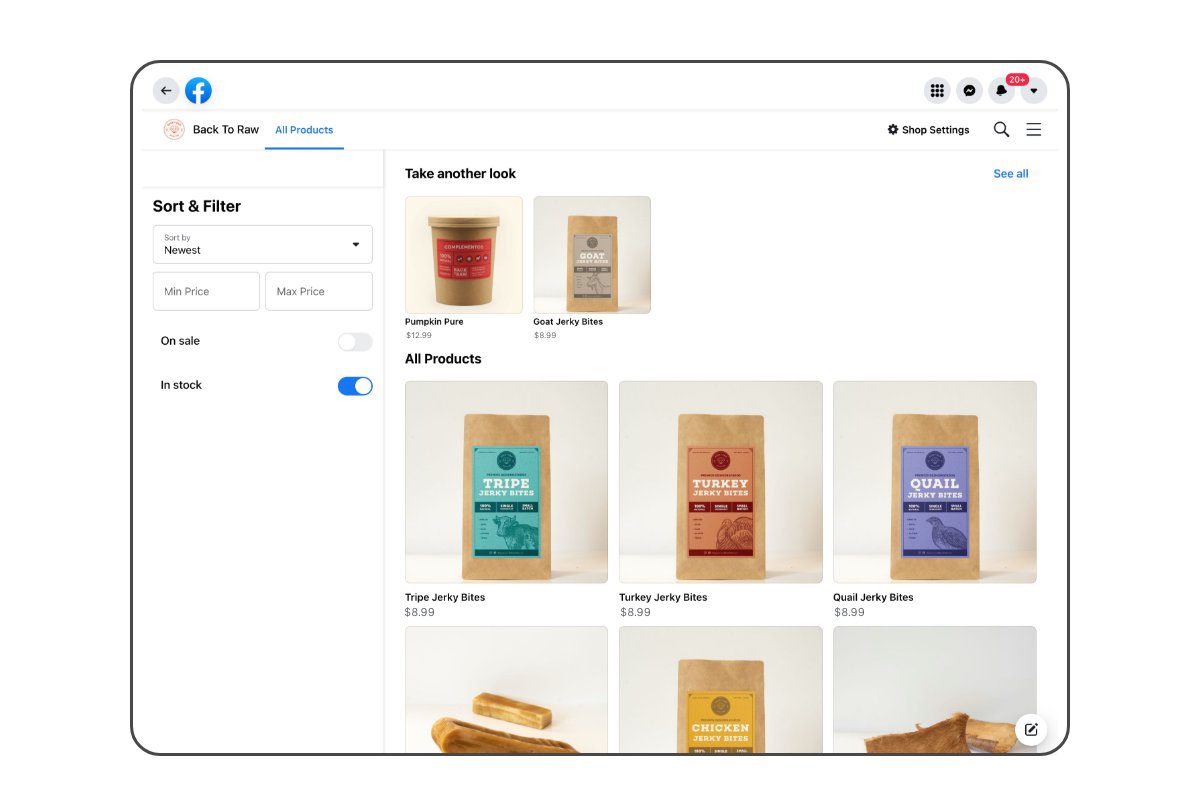By Miva | November 8, 2021

See why top ecommerce brands use Miva’s no-code platform to run
multiple stores, manage massive catalogs, and grow their revenue.
Social media has grown into a major place for online shoppers to share their purchases, recommend items to others, and find special promotions. Social media platforms are increasingly incorporating native commerce features to make it easy for users to buy, and savvy marketers are taking advantage of this trend by combining social and ecommerce into a seamless online experience.
According to Insider Intelligence, US social commerce sales will increase by 35.8% to $36.62 billion in 2021. Social commerce is what happens when savvy marketers combine the best of ecommerce with social media.
In this article, we discuss the trend of social commerce and how to leverage it for your business to generate results. Learn how to encourage product discovery, aid in research, and drive sales on your social media channels.
Social commerce is a sales model that involves selling products and items directly on social media. The shopping experience—from product discovery to the checkout—takes place almost entirely on the social media platform or app. For example, a user can browse for sunglasses on Facebook, see photos and videos of the ones they like, and then buy the item without having to go to the company’s website.
Social commerce can be defined as the merging of people socializing online and people shopping online—activities like liking and recommending products can now lead to users directly purchasing. Social commerce occurs when a user’s shopping experience happens directly within a social media platform. In today’s increasingly social media-driven and tech-savvy society, social commerce can provide valuable opportunities for businesses.
Social commerce interactions can also include:
Social commerce and ecommerce both involve online transactions. However, while ecommerce happens on a company’s digital store or branded app, social commerce occurs on a social media platform, combining the social media experience with a streamlined checkout process.

Social commerce is used to create a more interactive, direct, and personal experience to complement leading users to an online store. With social commerce, your followers can easily connect with their friends about your products, show off new purchases, interact directly with your brand, and even make a direct product purchase on some platforms. Social commerce allows brands to remove drop-off points and create a more seamless brand experience.
Here are some reasons for using social commerce:
Because points of customer interaction can occur in one place, social commerce helps to remove friction and eliminate distractions from the consumer journey, making it easy for customers to follow through from discovery to purchase.
Social media is alive with conversations, comments, and engagement from users—this provides sellers with a wealth of customer information and feedback, from products that they like and don’t like to content they want to see brands. Savvy marketers can use this feedback to inform their product development, product selections, and social messaging and strengthen their social strategy overall.
Social commerce is driven primarily by tech-savvy Millennial and Gen Z shoppers, who seek to connect with their favorite brands and influencers on social media. If your target demographic falls in the 18 to 34 age range, social ecommerce can add an element of convenience for these ready-to-buy shoppers, allowing your business to better attract, motivate, and engage them.
Social media platforms are powerful sources of customer data. With these resources at your fingertips, you have the opportunity to hyper-target your advertising. Your products can be directly targeted to relevant users, and you can provide an easy-to-buy experience right in front of them.

Social commerce works because it is an extension of what online users do on a daily basis—consuming content and engaging with friends and brands—and making it easy for them to shop and buy products. According to Insider Intelligence, almost 36% of online users in the US will make at least one social commerce purchase in 2021.
Because the entire shopping experience is kept within the social platform, social commerce is intuitive. Users can explore product photos, read comments as social proof, and purchase items in a one-stop experience. In essence, social commerce allows brands to meet people where they are.
Some of the most notable social media platforms have a degree of commerce features in their platform based on their audience size, strengths, and focus.
To succeed in social commerce, you need to determine the social media channels that will be best suited for your products—for example, fashion items will stand out on visual platforms like Instagram and Pinterest while tech and gadgets can thrive on Facebook or Twitter. You’ll want to use platforms where your audience spends most of their time.
Here are some of the top social media platforms that brands are using social commerce:
Facebook is the top social commerce platform in the US with over 56 million buyers. The massive platform has some of the more sophisticated features for social commerce. Brands can import or create their catalog, build an entire curated online store, run targeted ads, get valuable insights and interact directly with customers as they would on a social store.
Instagram is a top social platform for product discovery because of its emphasis on visual content. With Instagram’s shoppable posts, sellers can tag products within their posts, showcase photos with compelling visual posts, and move shoppers through the entire buyer journey. An Instagram ecommerce shop can drive sales and direct high-intent traffic to your website, opening new opportunities to engage visitors.
Pinterest first entered the social commerce arena with buyable pins. Like Instagram, Pinterest is highly visual—to succeed, sellers will want to use high-quality photos, and ensure strong product representation. However, unlike Facebook and Instagram, Pinterest directs users to your website. Pinterest users still have buying intent, giving you an opportunity to convert with by delivering a strong user experience on your site.
TikTok is a newer player in the social commerce industry. The platform’s algorithmic strength and highly engaged tech-savvy user base offer the potential for forward-thinking businesses to achieve rapid growth.
While Twitter no longer has shopping features (as of 2017), the platform allows brands to engage in social listening and use audience conversations to develop a strong social commerce strategy on other platforms.
Like Instagram, Snapchat gives some of its top-tier influencers the ability to add “Shop” buttons to their content, making the platform another option for businesses looking to drive sales through influencer partnerships.

While there is no one-size-fits-all approach to marketing (since a social shopping experience for fashion items is going to look very different from a campaign for technology), all brands can utilize similar tactics to successfully compete in the social commerce market. Some of these tactics are:
Social media users love videos, and videos are an effective way for you to market your products. Unboxing videos, tutorials, product explainers, and user-generated content are examples of videos that can resonate with shoppers and help them make buying decisions. With advertising targeting options available on social media, you can make sure your videos are seen by the right people.
Today’s online shoppers want to interact with brands and actively engage with products and services before making a purchase. They want to see interactive content like animated images, videos, quizzes, and polls to get a feel for what it would be like to purchase a product or service from a brand. By levering interactive content on your social media, you can drive audience engagement, draw attention to your products, and build customer relationships that lead to a purchase.
User-generated content is also great for social ecommerce. Photos, videos, and short reels from followers can help spark engagement with new and potential customers and build trust for your brand. Combined with effective call-to-action steps, UGC can help marketers create authentic experiences across every point in the buyer’s journey.
Influencers and celebrities can be a powerful source for obtaining user-generated content and expanding your audience. Some influencers even have the ability to create shoppable posts and add a “shop” button to their profiles. Combined with memorable and eye-catching content, influencers can serve as powerful brand advocates throughout the social media purchase journey.

So you’ve set up your social commerce shop, created new content, and now you’re ready to sell. Here are some tips and tricks to increase sales.
As your business engages in social commerce, you need to continually measure, analyze, and fine tune your strategies. You’ll want to find out what works on each social platform so that you can replicate your success and uncover new opportunities. You can do this by monitoring your social analytics to evaluate performance, see top sales-driving posts, and adjust and optimize your strategy.
To get more out of your social commerce strategy, you also need to conduct research to better understand your audience, including what they purchase most often and how they discover your products. You can apply these insights to inform the type of products you sell and the approach you take to marketing them to your audience.
More and more users are turning to social media for product reviews and recommendations. Reviews help build a positive reputation, establish customer trust, and remove hesitation from the social media buying process. Encourage reviews from your customers and share them in creative ways like user-generated content, live videos, or a carousel of positive comments. As customers follow you, purchase from you, and engage with your content, social media algorithms will deem your brand relevant to even more potential customers.
Use your platforms to answer customer questions, provide direct product recommendations, offer engaging and authentic content, and help people move forward with their shopping journey. Consider providing a chatbot to help automate the communication process. This helps turn online social media browsing into a trustworthy and engaging experience that keeps users in the buying journey.
People are turning to social media for more areas of their life. Social commerce bridges the gap between social media engagement and commerce, giving sellers the opportunity to add another sales channel to their business.
Social commerce is just one piece of your online strategy, one that should be supported by a solid ecommerce marketing strategy. Download our guide and learn how to create an effective marketing engine that sets you apart from the competition:
Back to topNo worries, download the PDF version now and enjoy your reading later...
Download PDF Miva
Miva
Miva offers a flexible and adaptable ecommerce platform that evolves with businesses and allows them to drive sales, maximize average order value, cut overhead costs, and increase revenue. Miva has been helping businesses realize their ecommerce potential for over 20 years and empowering retail, wholesale, and direct-to-consumer sellers across all industries to transform their business through ecommerce.
Visit Website